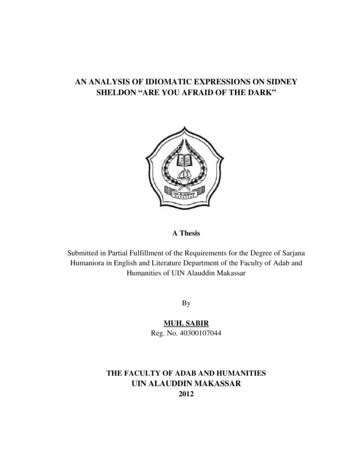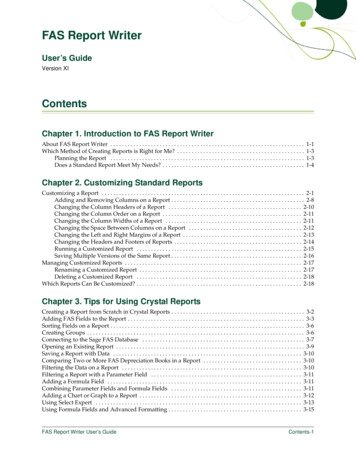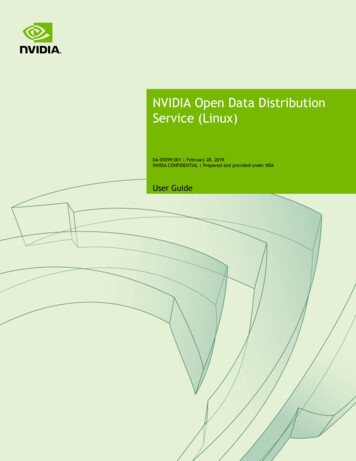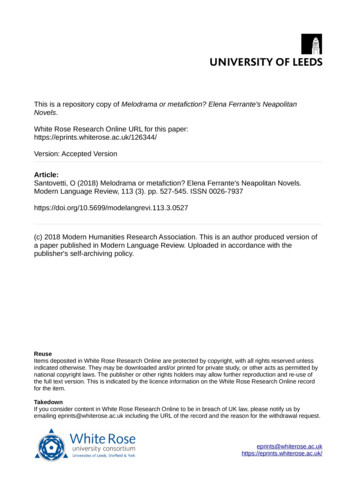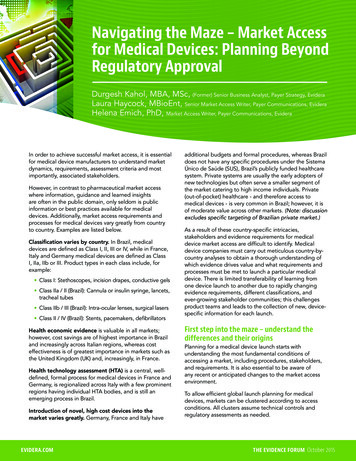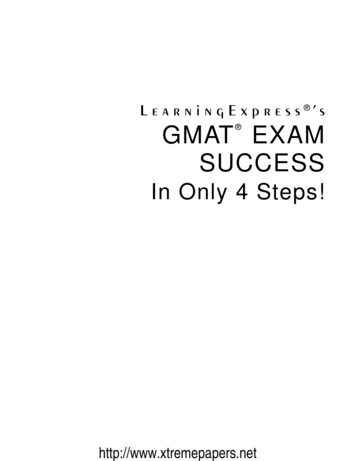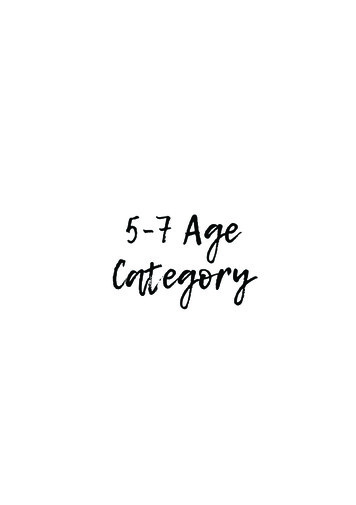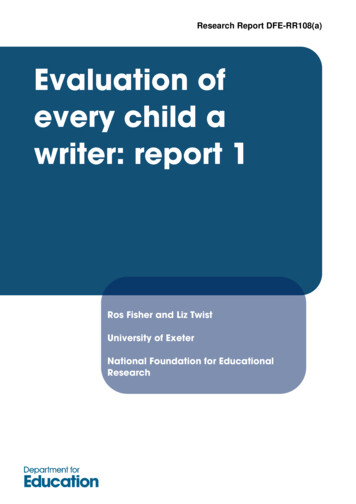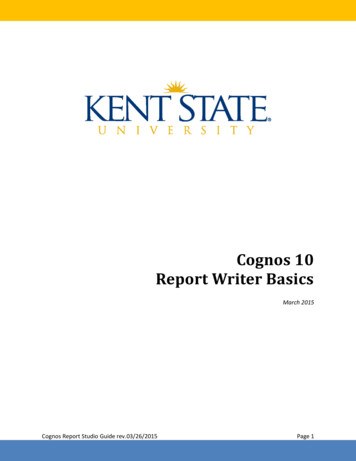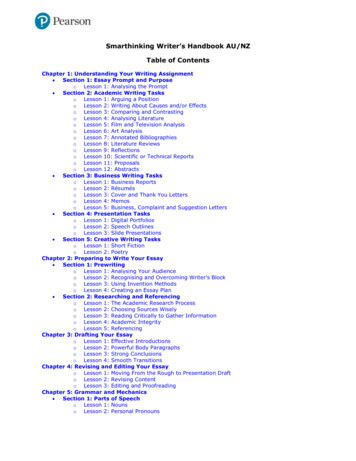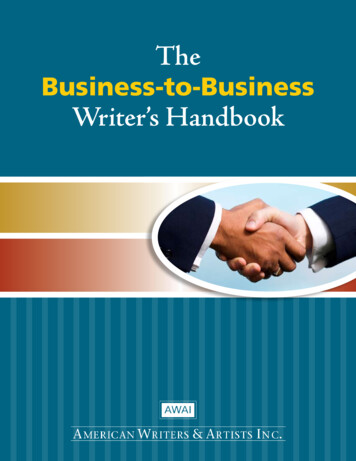
Transcription
TheBusiness-to-BusinessWriter’s Handbook
Copyright 2009 by American Writers & Artists Inc.All rights reserved. No part of this publication may be reproduced ortransmitted in any form or by any means, electronic or mechanical,including photocopying, recording, or by any information storage andretrieval system, without permission in writing from the publisher.Published by:American Writers & Artists Inc.245 NE 4th Avenue, Suite 102Delray Beach, FL 33483Phone: 561-278-5557 Fax: 561-278-5929Website: www.awaionline.com
The B2B Writer’s HandbookSecrets of LE of CONTENTSIntroduction . . . . . . . . . . . . . . . . . . . . . . . . . . . . . . . . . . . . . . . . . . . . . . . . . . . .1Print Advertisements . . . . . . . . . . . . . . . . . . . . . . . . . . . . . . . . . . . . . . . . . . . . . .2Banner Advertisements . . . . . . . . . . . . . . . . . . . . . . . . . . . . . . . . . . . . . . . . . . . .9Ezine Advertisements . . . . . . . . . . . . . . . . . . . . . . . . . . . . . . . . . . . . . . . . . . . .11Search Engine Advertising . . . . . . . . . . . . . . . . . . . . . . . . . . . . . . . . . . . . . . . . .12Advertorials . . . . . . . . . . . . . . . . . . . . . . . . . . . . . . . . . . . . . . . . . . . . . . . . . . . .14Directory and Classified Advertising . . . . . . . . . . . . . . . . . . . . . . . . . . . . . . . . .16Billboard Advertisements . . . . . . . . . . . . . . . . . . . . . . . . . . . . . . . . . . . . . . . . .17Catalog Item Descriptions. . . . . . . . . . . . . . . . . . . . . . . . . . . . . . . . . . . . . . . . .18Direct-Mail Packages . . . . . . . . . . . . . . . . . . . . . . . . . . . . . . . . . . . . . . . . . . . . .20Bonus: The B2B Writer’s HandbookI
Self-Mailers . . . . . . . . . . . . . . . . . . . . . . . . . . . . . . . . . . . . . . . . . . . . . . . . . . . . 29Dimensional or 3-D Direct-Mail Packages . . . . . . . . . . . . . . . . . . . . . . . . . . . . 31Email Marketing . . . . . . . . . . . . . . . . . . . . . . . . . . . . . . . . . . . . . . . . . . . . . . . . 33Landing Pages . . . . . . . . . . . . . . . . . . . . . . . . . . . . . . . . . . . . . . . . . . . . . . . . . . 39Microsites . . . . . . . . . . . . . . . . . . . . . . . . . . . . . . . . . . . . . . . . . . . . . . . . . . . . . 41Point-of-Sale Copy . . . . . . . . . . . . . . . . . . . . . . . . . . . . . . . . . . . . . . . . . . . . . . 43Sales Proposals . . . . . . . . . . . . . . . . . . . . . . . . . . . . . . . . . . . . . . . . . . . . . . . . . 45Radio Advertising . . . . . . . . . . . . . . . . . . . . . . . . . . . . . . . . . . . . . . . . . . . . . . . 49SEO Copywriting . . . . . . . . . . . . . . . . . . . . . . . . . . . . . . . . . . . . . . . . . . . . . . . 51Tele-Selling Scripts . . . . . . . . . . . . . . . . . . . . . . . . . . . . . . . . . . . . . . . . . . . . . . 53Trade Show Exhibits . . . . . . . . . . . . . . . . . . . . . . . . . . . . . . . . . . . . . . . . . . . . . 57Articles . . . . . . . . . . . . . . . . . . . . . . . . . . . . . . . . . . . . . . . . . . . . . . . . . . . . . . . 59Audio-Visual Scripts . . . . . . . . . . . . . . . . . . . . . . . . . . . . . . . . . . . . . . . . . . . . . 63Brochures . . . . . . . . . . . . . . . . . . . . . . . . . . . . . . . . . . . . . . . . . . . . . . . . . . . . . 69Case Studies . . . . . . . . . . . . . . . . . . . . . . . . . . . . . . . . . . . . . . . . . . . . . . . . . . . 74Press Release . . . . . . . . . . . . . . . . . . . . . . . . . . . . . . . . . . . . . . . . . . . . . . . . . . . 79Video News Release . . . . . . . . . . . . . . . . . . . . . . . . . . . . . . . . . . . . . . . . . . . . . 83Presentations . . . . . . . . . . . . . . . . . . . . . . . . . . . . . . . . . . . . . . . . . . . . . . . . . . . 85Web Pages . . . . . . . . . . . . . . . . . . . . . . . . . . . . . . . . . . . . . . . . . . . . . . . . . . . . . 87White Papers . . . . . . . . . . . . . . . . . . . . . . . . . . . . . . . . . . . . . . . . . . . . . . . . . . . 92Taglines and Slogans . . . . . . . . . . . . . . . . . . . . . . . . . . . . . . . . . . . . . . . . . . . . . 99Copywriter’s Rough . . . . . . . . . . . . . . . . . . . . . . . . . . . . . . . . . . . . . . . . . . . . 103IIBonus: The B2B Writer’s Handbook
IntroductionAt the beginning of Secrets of Writing High-Performance Business-to-BusinessCopy, I made you a promise. To give you everything you need to become aknowledgeable, skilled B2B copywriter, whether you’re just starting your career orbusiness, or want to take your current career or business to the next level of success.That’s why I want you to have this handy guide as a bonus. This guide givesyou how-to instructions and tips for tackling more than 30 business-to-businesscopywriting projects. Everything from trade-show exhibits and sales proposals toSEO copywriting and even billboards! No matter what kind of project your clientthrows your way, you’ll be confident and prepared to say “yes!”Keep this guide in a place you can find it for easy reference because I know you’regoing to want to refer back to it time and again.Here’s to your success!Steve SlaunwhiteB2B Copywriting Expert& AWAI Advisor Board MemberBonus: The B2B Writer’s Handbook1
Print AdvertisementsPrint ads can be published as a two-page, full page, partial page, classified, FSI(free standing insert) and numerous other sizes and formats.The basic ingredients are relatively simple:n A headlinen A visualn Body copySome ads are just a headline. Others are just a visual. But in the majority ofbusiness-to-business print ads you’ll find all three of these elements at play.Here’s an example:How will you find a better solutionto fixed asset accounting?Follow the crowdMore than 3,000 satisfied users – and growing! – rely on WorthITFixed Assets. And for good reason. It’s the only application that lets youmanage, depreciate and budget fixed assets faster and more accuratelythan you ever thought possible.A powerful, versatile solution, WorthIT boosts productivity, reduces costsand saves you money. It’s remarkably easy-to-use – and worksseamlessly with your existing spreadsheet and accounting systems.How do you learn more? Call our Information Hotline today. And be sureto ask about our FREE 50-Day Use offer.FIXEDASSET A better way to manage,depreciate and budgetfixed assets.Information e how the headline, visual and body copy accomplish all the things we’velearned about in Chapters Five and Six gain attention, identify a problem, presentthe solution, etc.2Bonus: The B2B Writer’s Handbook
An awareness or imagine ad is designed to gain mindshare with the business buyer. These typesof ads attempt to get the prospect to remember the product and its advantages, and thinkabout it in a positive way. Direct marketers tend not to like these types of ads because there isno accurate way to measure effectiveness. Response to a direct marketing ad, by contrast, canusually be tracked precisely.Business-to-business ads are used primarily for awareness-building and leadgeneration. Rarely do you see an ad that attempts to make the sale in one step, butthere are some. I recently came across an advertisement in a trade publication witha special, time-limited offer if your ordered before a deadline. The ad included a1-800 order line and special discount code to quote when you called.In addition to what we’ve already learned in previous chapters about writingpersuasive copy, here are some additional tips applicable specifically to printadvertising courtesy of one of the leading experts in business-to-business leadgeneration, Mac MacIntosh.If you want more sales leads, don’t use image adsHave you seen the ads showing butterflies and oil wells co-existing, illustrating theoil company’s concern for the environment? This kind of advertising may do a lot toimprove the company’s image, but it isn’t designed to generate leads.If leads are what you want, focus your advertising’s message on the benefits andapplications of your products or services. Then let the layout and design of your adsenhance your company’s image.Put benefits in your headlines.If you put a benefit in the headline you’ll have a better chance of catching thereader’s attention and generating an inquiry or request for more information.If after reading the headline a reader can ask “so what?” you probablydescribed a feature instead of a benefit. The answer to “so what?” is probablythe benefit.Bonus: The B2B Writer’s Handbook3
Talk about applications.If your product or service is ideal for specific applications, say so. Whenreaders recognize their application for your product or service they will bemore likely to respond. For example, you’re more likely to get an inquiry fromsomeone in a medical records department of a hospital if they notice thatyour barcoding software is idea for tracking patient’s medical records.Make your ads easy to skim.Everyone seems pressed for time these days, including the folks reading thetrade publications you advertise in. With this in mind, make it easy for readersto “skim” your ads and still get the message. Use bulleted copy, subheads andillustrations or photos to quickly communicate key points.Testimonial ads are king.I’ve seen testimonial ads boost the number of sales leads my clients’ adsgenerate by up to 700%. Your prospects expect you to be biased. However,they trust their peers to tell it like it is. Use this to your advantage by includingquotes from happy customers in your advertising. Or mention the companiesyou serve. Or use statistics like “chosen by 9 out of 10 design engineers.”However, to be believable you have to be specific. For example, give the fullname, title and company affiliation of the person being quoted. Or list thenames of a few respected companies who use your products or services. Ifyou use statistics, be sure to back them up by referencing the source of thedata.Fractional ads in every issue can be more cost-efficient.If you want more leads, your advertising needs to be present when yourprospects are looking for solutions to their problems. So, if your budget islimited, rather than placing only a few full-page ads a year, consider runningfractional ads in every issue. Having ads in every issue also makes yourcompany look bigger and more successful.Use “’Wrap Ads” to get more bang for the buck.“Wrap Ads” are actually a number of fractional ads, designed to look like newproduct announcements, all run on a single page surrounding an “island”half-page ad. This format can also work for half-page and third-page ads.Although more common in tabloid-sized magazines, this type of ad works4Bonus: The B2B Writer’s Handbook
equally well in standard-sized publications.My clients have found that wrap ads can pull up to 400% more inquiries thana single ad of the same size.Make them an offer they can’t refuse.If you want your prospects to respond, you have to give them a convincingreason to do so. Keep the phrase “what’s in it for me?” in mind as you’rewriting your ad’s call to action. It’s what your prospects are thinking as theydecide whether or not they will take the time or effort to respond.Consider offering application notes showing how other buyers solved theirproblems using your product or service.Offering a useful premium or advertising specialty can also significantlyincrease the number of responses. However, try to make sure your offer is ofinterest only to qualified prospects. For example, a tool for sizing rings wouldbe an attractive offer only to people who use rings. However, everyone mightwant a free pocket screwdriver set and inquire only to get it, not because theyhave a need for your product or service.Many of your prospects may want to try your product before they buy it.If you can cost-effectively offer samples or a demonstration CD, you willgenerate more inquiries.Choose your words carefully.The word “free” is a powerful inquiry generator. Everyone wants somethingfor nothing. Direct marketers have long known the power of this word. Take alook at just about any direct response ad and you’ll see it used.“New” is another word that is sure to attract attention and generate moreinquiries. Legally, however, you can only use “new” if it is new, and only for alimited period of time (usually 6 months). Check with your legal advisor.Talk first person with the reader.Use words in your copy like “you” and “your” to focus on the readers’ needsrather than boasting about how good “we” and “our” products or servicesare. For example, the statement “You will get the work done 25% quicker” ismuch stronger than “Our product is 25% faster than the competition.”Bonus: The B2B Writer’s Handbook5
Ask for the order.Any experienced salesperson can tell you, you won’t get the order unless youask for it.Create benefit-oriented offers such as “call, write, fax, e-mail or visit ourwebsite today to request your free Component Selection Guide, designed tohelp you quickly determine which products best meet your barcoding needs.”Notice that even the words “Selection Guide,” as opposed to “brochure” or“catalog,” were chosen to offer the reader a benefit.Give them a compelling reason to inquire right away.You’ll get more inquiries if you design your offer to reward those who inquireright away. For example, try something like “If you are one of the first 500 toinquire, we’ll also send you a free booklet entitled, “fifteen ways to cut yourinventory costs.” Or “Request more information before December 31st, andwe’ll include a coupon good for 500 worth of free accessories.”Match your offers to where the reader is in the buying cycleWhen prospects are just starting to gather information, they may needliterature but are often not yet ready for a sales call. When it is almost timeto buy, prospects are usually anxious to speak with your salespeople, reps,resellers or distributors, see a demonstration or discuss pricing.You can significantly increase the number of inquiries you generate by makingoffers that have appeal to prospects in all phases of the sales cycle. Forexample, consider offering Selection Guides, application notes, a newsletter,a demonstration, a test or analysis, samples, a sales call or any combinationthereof.Merchandise your offer.Direct marketers have found that how you package the offer can be asimportant as the offer itself.For example, if you’re offering literature or samples, include in the ad a smallpicture of what they’ll receive if they inquire. If you use a coupon, show alittle pair of scissors cutting out the coupon. If you use 800 numbers in yourads, make sure the numbers are big and bold. That way they stand out andit’s clear that you want the prospect to call.Don’t forget to mention all the ways they can inquire; “circle the number6Bonus: The B2B Writer’s Handbook
below, call, fax, contact us by e-mail or visit our website today for your freeinformation kit.”Make it easy for your prospect to respond.Offer multiple response devices so your prospects can choose the methodthey prefer.For example, some people need your information right away, so they preferto call or to go right to your website on the Internet. Some like the 24-hourconvenience of faxing or e-mailing their requests. Others find it easier ormore comfortable to use the magazine-provided reader service card, couponsor bound-in reply cards.Art directors tend to hate coupons, but they work. One study I recall showedthat the same ads with a coupon out-pulled versions without the coupon byas much as 13%.If you publish phone numbers in your ads, be prepared to answer the phoneduring coast-to coast business hours.Mention your website.Make it clear to readers that they can get the rest of the story about yourproducts or services instantly by visiting your website. Then make sure yourwebsite makes it easy for them to find this information.In addition, have an “Information Request” button on every page that takesthem to a form that allows them to identify themselves and their needs, andto request that detailed information be faxed, downloaded as files or quicklymailed to them.Consider using a unique web address for each ad you run so you’ll knowwhere the inquiry came from. Ask your Webmaster about this. It is easy andinexpensive to accomplish.Mac MacIntosh has consulted for more than one hundred major businessto-business companies. He really knows his stuff. Check out his website atSalesLeadExperts.com. It’s packed with resources.In addition to Mac’s terrific tips for creating effective advertising, I would also add:v Spend time on the headline.This is by far the most important component an ad. Spent the time necessaryBonus: The B2B Writer’s Handbook7
to get it right. Brainstorm. Develop a list of possibilities. Scrutinize each oneuntil you come up with a potential winner. The body copy and visuals may beimportant. But it’s the headline that will often make or break your ad.v “Put a coupon in your ad.”Bob Bly advises in Business-to-Business Direct Marketing. “Coupons visuallyidentify your ad as a direct response ad, causing more people to stop andread it or at least look at the coupon to see what they can get for free.”8Bonus: The B2B Writer’s Handbook
Banner AdvertisementsBanners are booming. Jupiter Research estimates spending of this type ofadvertising to be 16 billion, with B2B companies representing a sizable chunk.I love writing banner ads. They’re short, challenging and fun. And considering thetime it takes to write one — for me, usually less than two hours — it pays very well.No doubt you’ve see banner ads with a lot of flash, fancy graphics, animation andother visual gimmicks. These can work wonders in gaining attention. But it’s thewords used in the banner that determines if it gets clicked or ignored.And speaking of words, you have few to work with. Most banners have room forless than ten words. Barely enough for a headline and, perhaps, just a few words ofbody copy. So, as a copywriter, you have to make every word count.Take a look at this example, written by Joan Damico. (It’s a single banner ad thatdisplays the text in a sequence, like a show.)This banner is little more than a headline with a few short subheads.Yet, it does all the work, from gaining your attention (not easy whenyou consider it is competing with everything else that’s on the webpage!) to motivating you to take action.How does a banner work? Usually, it’s the first part of a two-partcampaign. When you click the banner (part one), you’re taken to alanding page or microsite that completes the sales or lead-generationprocess (part two.) We’ll discuss landing pages and microsites later inthis handbook.Here are some tips for writing effective banner ads from mybook, The Everything Guide To Writing Copy.n Focus on what the readers will get when they click on thebanner. That could be a free report, free shipping, an onlinedemonstration, or a virtual tour.n Edit the copy to its bare essentials. Get rid of any extraneouswords (often these are the adjectives) that don’t addmuch oomph to the sales message.Don’t assume that the reader will know they have to click onBonus: The B2B Writer’s Handbook9
the ad. Make sure you clearly say, “Click here,” “Go there now”, “Visittoday,” or some other call to action.n If possible, work closely with a graphic designer. Make sure the layoutand the images are as motivating as the text. The graphics should help thereader see the benefits. For example, a banner ad for a travel destinationmight show a family throwing a Frisbee on the beach.n For animated banners, make sure each image is effective on its own. For anynumber of technical reasons, the prospect may not see all the images.n For banners that contain audio and video, make sure the ad works wellwithout sound. The prospect may have his or her computer speakers turneddown or off.10Bonus: The B2B Writer’s Handbook
Ezine AdvertisementsEzines — also known as online newsletters, email newsletters, and e-newsletters— are a popular means of staying in touch with prospects and customers as well asconnecting with specific audiences. “The Golden Thread”, which you may receivefrom AWAI, is an ezine.In addition to articles and other editorial, many ezines also have advertising, justlike traditional print magazines and newspapers.Here’s an example of a typical ezine ad.*************************************TODAY’S SPONSOR: Exent Technologies*************************************A better way to deploy applications? Find out! You’re invited to a FREE DEMO ofEXEtender[tm] from Exent Technologies. Learn how you can effortlessly stream Windowsapplications, like StarOffice[tm], to your clients over the Internet. No expensive back endservers required. Looking for a new revenue stream? View this free demo right now at:http://www.exent.com/demo/aspWhat’s the difference between writing an ezine ad and a banner?Ezine ads are almost always entirely text based. Unlike banner advertising, specialeffects and graphic design play a much smaller, if any, role.In regards to text, you also have more room. While banner ads can restrict youto just a single line of copy, you have several lines available to you in an ezineadvertisement. You can often write a headline, a paragraph or two of copy, and thenadd a link. Just like a banner ad, when you click on the link, it takes you to a landingpage or microsite.Ask your client to tell you how many lines of copy or words you have to work with.If he or she doesn’t know, ask for the address of the ezine’s website. The publisherwill often post advertising guidelines somewhere on the site.Writing an online space ad is not much different than writing a print space ad. Sovirtually all of the tips listed earlier in this handbook apply.A caveat: You’ll likely have to work even harder to create a headline that grabs andholds attention. Remember, you’re trying to motivate the reader to click away fromhis enjoyable article and to your promotion. Not easy.Bonus: The B2B Writer’s Handbook11
Search Engine AdvertisingHow do you find something on the Internet? Chances are, you “Google it”. (OrYahoo! it. Or AOL Search it.)Guess what? Business buyers do the same thing. If they’re looking for a printer, alist broker, a tax consultant, a caterer for the company picnic, they will often typewhat they’re looking for into one of the dozens of search engines available on theWeb.Let’s say, for example, you’re an business manager looking for office furniture,and your company is located in Boston. You might go to Google.com and type in“Office Furniture, Boston”. In fact, let’s do that right now.12Bonus: The B2B Writer’s Handbook
Those ads you see highlighted at the top and right of the search results are calledSponsored Ads. These are ads that the companies have paid to have appear whencertain words or phrases are typed into the search field.Search engine ads are soaring in popularity. Companies see them as a way to getaround the increasingly difficult task of getting their website listed at the top ofsearch results. A few months ago, I had never written a search engine ad for a client.This month I’m writing two. And I expect to be writing many more as this kind ofadvertising grows.What are the elements of a Search Engine Ad?Typically, it’s just three lines. The first is the headline, less than five or six words.Then two short lines of body copy. That’s a total of less just 15 words or so to gainattention and motivate the prospect to act. And there’s no fancy graphic design tohelp you. No wonder the copy is so important!When writing a search engine ad, apply the basic principles of ad writing thatwe’ve covered earlier in this handbook. One caveat: never repeat information. Youjust don’t have the room. “Short, non-repetitive sentences work best,” advisesGoogle.com in their advice to advertisers.Here’s a great writing tip from search engine expert Karon Thackston, “Start bigand narrow it down,” she suggests in her article How To Write Little Tiny AdWordsAds That Bring Giant-Sized Profits, “Begin by writing a few sentences or a paragraphabout what you’d like your customer to know Now, go back and take out everyword that does not absolutely need to be there.”Bonus: The B2B Writer’s Handbook13
AdvertorialsAn advertorial is essentially an advertisement written and designed to mimicthe editorial materials in a magazine, newspaper or ezine. It’s a combination ofadvertisement and editorial hence, adver-torial.Because it appears to be an article, readers assume it contains useful information— and the best usually do — which is why advertorials tend to have a much higherreadership than traditional advertising.Now, that doesn’t mean that advertorials are any less sales-oriented. They do needto get results in terms of leads and sales. But advertorials tend to explain rather thanpitch, which makes this approach seem softer and less “hard sell” than traditionalads.Copywriter Janice King says in Writing High-Tech Copy That Sells, “Advertorialscan be used to: present more information that can fit into a typical ad; support thedesired positioning for a product or company; or present the company’s viewpointon an issue or trend.”Sometimes an advertorial can take up all or part of a page in a publication.Sometimes it can be one of several advertorials that make up a multipage“advertising supplement”. Recently, my weekend newspaper featured a specialsection on Trade Show Success, made up entirely of advertorials.Here are some top writing tips for advertorials:4 Get the guidelines.Most newspapers and magazines have strict guidelines for advertorials requiring a specific font, layout, type, even editorial style. You don’t wantyour copy to be rejected by the publisher. So ask your client forthe publisher’s advertorial guidelines.4 Write it in article format.Don’t make it sound like an ad or sales letter. Articles are informative andnewsy.4 Don’t put an offer in the headline.“Buy Now And Save 50%” may work well in an ad, email or letter. But aheadline l ike this breaks the veneer of credibility you’re trying to createwith an advertorial.14Bonus: The B2B Writer’s Handbook
4 Read the publication.Unless the guidelines forbid this, write the advertorial in the same style, toneand format as the magazine it will be published in.4 Consider a case study.Case studies and success stories work extremely well as advertorials.4 “How-to” tips work well.Any practical strategies that the reader can use to solve problems, makedecisions, do his or her job better, make more money, achieve specificobjectives, etc. are very effective in advertorials.4 Avoid discount offers.There’s nothing wrong with putting a compelling offer in your advertorial.In fact, I suggest it. The best offers are information-oriented; case studies,booklets, white papers. Discounts and special pricing, by contrast, donot work well.4 Use captions.Always write text to go with photos, charts and illustrations. Everyone readscaptions.4 Use a byline.This makes your advertorial look like a “real” article. You can use your name,your client’s name, or even a pen name. Just the existence of a byline itselfbuilds credibility.4 Use quotes.Featuring quotes from key people in the company or from customers can bevery effective. For example: “’Upgrade burnout is a serious issue amongsoftware users,’ says John Smith, Director of User Documentation. ‘That’swhy we now include six training DVDs that make it easy to ’”4 Don’t forget it’s an ad.It may look like an article, but it isn’t. So close with a strong call to action —ideally, a compelling offer — that motivates the reader to take the next step.Bonus: The B2B Writer’s Handbook15
Directory and Classified AdvertisingB2B companies often advertise their products and services in industry directories,such as the Thomas Directory, and in the classified sections of business, trade andprofessional publications.These types of ads are often text-only, featuring only a headline and a few lines ofbody copy. However, there are some that can include images and, in some cases,look like a traditional print or online advertisement. Here’s an example:Want more referrals and repeat business?Written exclusively for REALTORS, the Referral & Repeat MarketingHandbook provides you with a step-by-step system for doing just that.Imagine. No more cold calls! To find out how to get your FREE copy,visit www.ReferralAndRepeat.com.When a business buyer searches a directory or the classifieds section of apublication, he’s looking for something. They are in “buying mode”. And as acopywriter, you need to keep this in mind. Make sure that your headline and offershouts loud and clear, “Here! Here! This is what you’re looking for. You’ve found it!”For example, if a buyer is looking for used filing cabinets, an ad that actually says“Used Filing Cabinets. Free Delivery!” i
2 Bonus: The B2B Writer’s Handbook Print Advertisements Print ads can be published as a two-page, full page, partial page, classified, FSI (free standing insert) and numerous other sizes and formats. The basic ingredients are relatively simple: n A headline n A visual n Body cop
